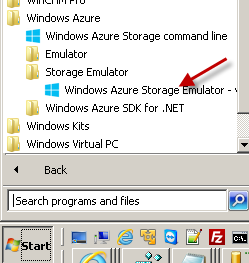

- #Start azure storage emulator how to
- #Start azure storage emulator code
- #Start azure storage emulator windows
The only way to use DefaultAzureCredential is with token based auth and it only supports HTTPSĪzurite is an open source Azure Storage emulator that supports Windows and Linux.
#Start azure storage emulator code
Here’s a table that summarizes the issues with each of the tools: ToolĪllows you to use the same credential objects for Dev and Production environments without code changes. If you find any of this post useful, then it is important that you either comment below or send me an email here: so we know that it is important to you, which will help us prioritize.

I’m using on Azurite instead of Azure Storage Emulator in this post because Azurite is open source and I figured out what needs to be done to get this to work.
#Start azure storage emulator how to

I’m going to break this post into two parts, one for the HTTPS issue and one for the Token Credential issue. By the end of this post you’ll be all setup to use DefaultAzureCredential with Azurite and Storage Explorer. Azurite does not support “Bearer Tokens”īut fear not, I have a solution for you. Token Issue: DefaultAzureCredential uses “Bearer Tokens”. Azurite and Storage Explorer do not support HTTPS. HTTPS Issue: DefaultAzureCredential requires HTTPS. So even if you run Azurite with HTTPS, you still need token support for DefaultAzureCredential, and Storage Explorer can’t talk to the HTTPS endpoints. The current problem is that Azurite doesn’t support HTTP or Token based authentication, which the new Azure Identity DefaultAzureCredential requires, and Storage Explorer only supports HTTP. Second, you love the new Azure Identity DefaultAzureCredential class and want to use it with your local emulation tools. You can emulate Azure Storage with Azurite and you can peek into your storage account with Storage Explorer. If you are like me, then first, you love to save money and not hit the cloud when you don’t have to use of local tooling and emulators is a great way achieve that. You won’t need to create a reverse-proxy anymore like I describe in this post below. Please see my new blog here for all the details. In this way, we will be able to run integration test with Windows Azure without any kind of problem.UPDATE - Azurite now officially supports HTTPS and OAuth. Public static void ClassInit(TestContext context)ĬloudStorageEmulatorShepherd s hepherd = new CloudStorageEmulatorShepherd() It is very important to set the NoRetry policty.Īnd in our unit test we would need something like this: We are testing if the emulator is started by trying to creating a container. This path can be extracted in the configuration file. The path to the emulator can be different, based on Windows Azure version. ProcessStartInfo processStartInfo = new ProcessStartInfo()įileName = Files\Microsoft SDKs\Windows Azure\Emulator",Īrguments = (Process process = Process.Start(processStartInfo)) Public class CloudStorageEmulatorShepherdĬloudStorageAccount storageAccount = CloudStorageAccount.DevelopmentStorageAccount ĬloudBlobClient blobClient = storageAccount.CreateCloudBlobClient() ĬloudBlobContainer container = blobClient.GetContainerReference("test") The code that we would need to use will look something like this: In the end, the emulator is only a process that can be started from the command line.

We can write a code in the class initialize step that star the emulator. But will happen on a machine where Windows Azure Emulator is not started. When we are on a development machine, where we already have Windows Azure Emulator stared we will not have any kind of problems. Usually for this this Windows Storage emulator is used in combination with development storage account. This would increase or monthly subscription costs. When working with Windows Azure, there are times when we want to write some integration test for Windows Azure tables, blobs or queues.įor these cases we don’t want to hit the Windows Azure from the cloud. Unit test need to be written even if we are working with on-premise services or with services from cloud.


 0 kommentar(er)
0 kommentar(er)
